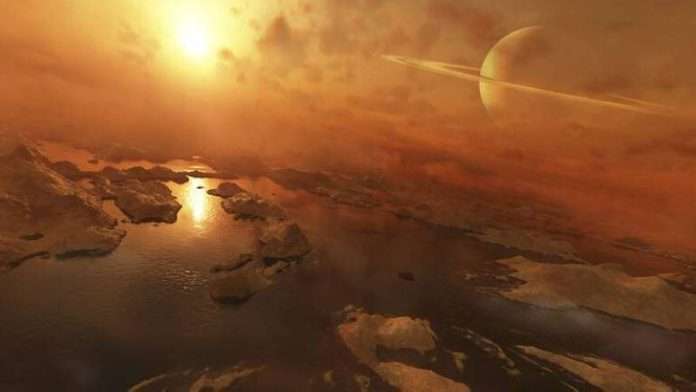Saturn’s largest moon has electrically charged sand, methane-filled lakes and a hazy atmosphere, but the James Webb Space Telescope discovered that Titan also has seasonal weather patterns.
Titan reminds us of Earth because of its hues of blue, and it’s the only other place in our part of the universe we know to have stormy seas and gorgeous clouds. But Titan is rather strange, as its clouds, seas, rivers and lakes do not consist of water, they are made of methane and ethane, reports a local Arabic daily.
And on November 5, scientists received some of the first images of Titan, taken by NASA’s revolutionary new James Webb Space Telescope.
Thanks to James Webb’s primary imaging instrument, which detects infrared light, the telescope spotted two clouds in Titan’s northern hemisphere.
And astronomers announced, Thursday, that the telescope detected bright spots in the northern hemisphere of Titan, which are large clouds, confirming the predictions of the computer model that clouds appear in late summer when the surface temperature rises due to the sun.
One of the clouds is located in the North Polar Region near Kraken Mare, the largest known liquid mass on Titan’s surface.
The clouds have not been seen before because of the thick haze in the atmosphere, which blocks visible light reflecting off the surface, but James Webb features infrared light that is able to penetrate the surrounding smog.
This discovery means that Titan is the only moon in the solar system with seasonal weather patterns, which is possible because it has the necessary atmosphere for this to happen.
Previous research shared last April found that Titan is surprisingly Earth-like in terms of landscape formations, with its dark-colored land and sand dunes.
The moon also features rivers, lakes and seas full of falling rain, although the rain is liquid methane, falling through nitrogen winds.
Scientists have long believed that Titan was unique compared to other moons in the solar system, and recent research has proven that their theories could be correct.
Follow-up analysis using the Keck Telescope, a ground-based observatory based in Hawaii, helped study how the clouds move or change shapes. This telescope helped see the clouds two days after James Webb’s first images were spotted, on November 6.
The team noted that the clouds were in the same position but appeared to change shape. This data has been sent to atmospheric modeling experts in hopes of interpreting the available data.
“I’m glad we’re seeing this, since we were expecting a good amount of cloud activity for the season,” said Juan Laura of Yale University, one of the experts involved in the data study. We cannot be sure that the clouds on November 4 and 6 are the same, but it is confirmation of seasonal weather patterns.
This will not be the last show by the James Webb telescope, as it is expected to send more data, and its “MIRI” instrument will provide the first data in mid-2023. This is especially exciting because Titan has not been seen in the infrared wavelengths that Used by MIRI, this should provide additional information about its atmosphere.

















